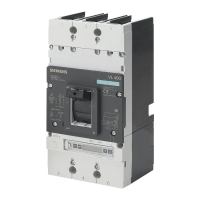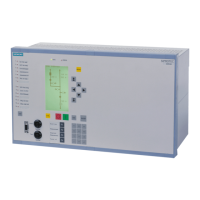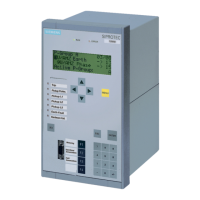Installing/mounting
7.2 Mounting and safety clearances
3VL molded-case circuit breakers
88 System Manual, 03/2009, 110 0110 - 02 DS 01
Table 7- 2 Permissible safety clearances in accordance with IEC 60947
A ≤ 415 V A > 415-690 V
Circuit
breaker type
Switching
capacity
With or without
covers
Without covers With covers
B ≤ 690 V C ≤ 690 V D ≤ 690 V
VL160X Standard High 35 mm 70 mm 35 mm 25 mm 25 mm 35 mm
VL160 Standard High
Very high
50 mm 100 mm 50 mm 25 mm 25 mm 35 mm
VL250 Standard High
Very high
50 mm 100 mm 50 mm 25 mm 25 mm 35 mm
VL400 Standard High
Very high
50 mm 100 mm 50 mm 25 mm 25 mm 35 mm
VL630 Standard High
Very high
50 mm 100 mm 50 mm 25 mm 25 mm 35 mm
VL800 Standard High
Very high
50 mm 100 mm 50 mm 25 mm 25 mm 35 mm
VL1250 Standard High
Very high
70 mm 100 mm 70 mm 30 mm 30 mm 50 mm
VL1600 Standard High
Very high
100 mm 100 mm 100 mm 100 mm 30 mm 100 mm
Definition of the permissible safety clearances in [mm] between
Q: Circuit breaker and current paths (uninsulated and grounded metal)
B: Circuit breaker phase terminal and lower panel
C: Sides of the circuit breaker and side panels left/right (uninsulated and grounded
metal)
D: Circuit breaker and non-conductive parts with at least 3 mm thick insulation
(insulator, insulated bar, painted plate)
If uninsulated conductors are connected to terminals 1, 3, 5 and 7, they must be insulated
from each other independently of the direction of the mains supply (see Chapter 3.1.1.). This
can be achieved using phase barriers or terminal covers.
Terminal covers must be used for the main terminals at voltages of ≥ 600 V AC
or ≥ 500 V DC.
Note
We recommend you also insulate connections 2, 4, 6 and 8 from each other for additional
safety.
(
(
Figure 7-3 Minimum clearance between two horizontally or vertically installed circuit breakers

